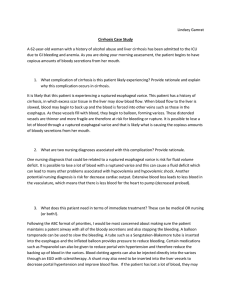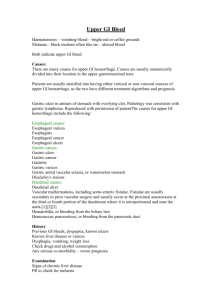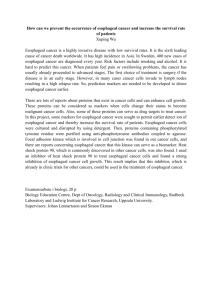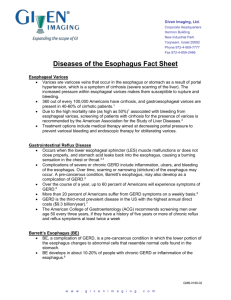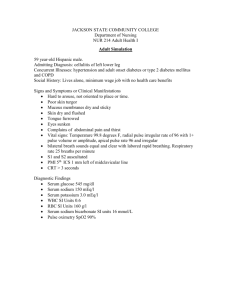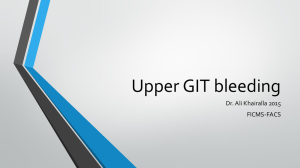Document 12560239
advertisement
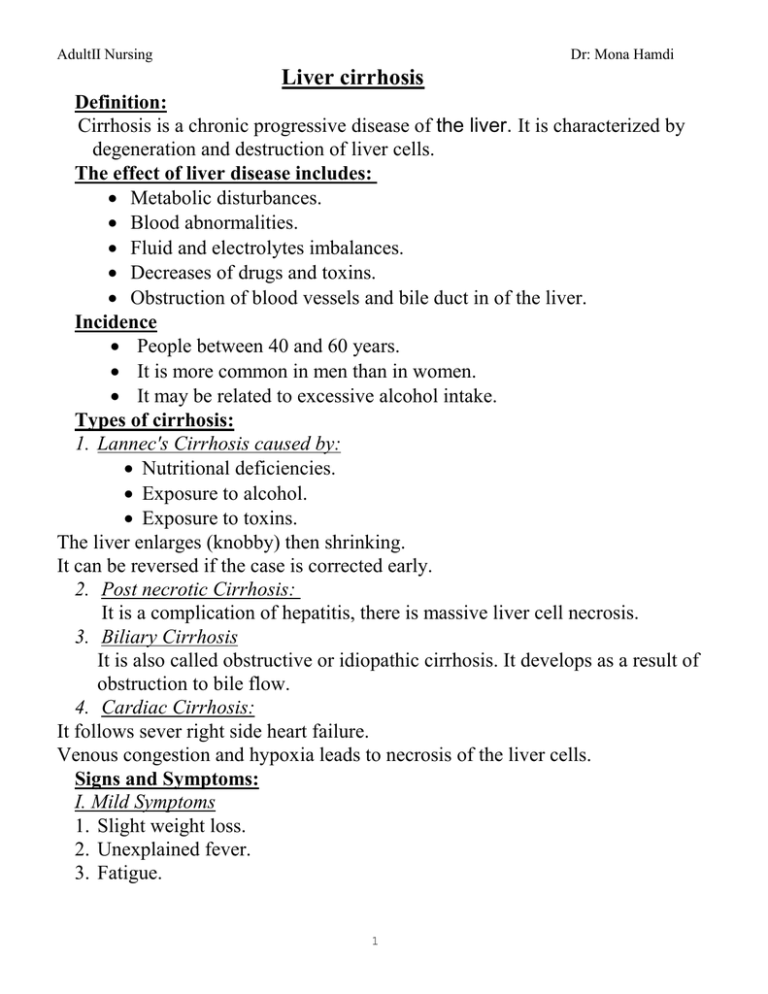
AdultII Nursing Dr: Mona Hamdi Liver cirrhosis Definition: Cirrhosis is a chronic progressive disease of the liver. It is characterized by degeneration and destruction of liver cells. The effect of liver disease includes: Metabolic disturbances. Blood abnormalities. Fluid and electrolytes imbalances. Decreases of drugs and toxins. Obstruction of blood vessels and bile duct in of the liver. Incidence People between 40 and 60 years. It is more common in men than in women. It may be related to excessive alcohol intake. Types of cirrhosis: 1. Lannec's Cirrhosis caused by: Nutritional deficiencies. Exposure to alcohol. Exposure to toxins. The liver enlarges (knobby) then shrinking. It can be reversed if the case is corrected early. 2. Post necrotic Cirrhosis: It is a complication of hepatitis, there is massive liver cell necrosis. 3. Biliary Cirrhosis It is also called obstructive or idiopathic cirrhosis. It develops as a result of obstruction to bile flow. 4. Cardiac Cirrhosis: It follows sever right side heart failure. Venous congestion and hypoxia leads to necrosis of the liver cells. Signs and Symptoms: I. Mild Symptoms 1. Slight weight loss. 2. Unexplained fever. 3. Fatigue. 1 AdultII Nursing Dr: Mona Hamdi 4. Abdominal pain described as heavy feeling in the right upper quadrant or epigastruim due to: stretching of the liver capsule , spasm of the Biliary ducts, and intermittent vascular spasm 5. Dull hearing in the right upper abdomen on percussion. 6. Liver is palpable below the right rib margin. II-Progress of Disease: 1. GIT disturbances; anorexia, vomiting, diarrhea or constipation, flatulence and dyspepsia (heart burn). This is due to impaired of carbohydrate, fat, and protein metabolism. 2. Bulged dilate veins in the esophagus is called esophageal varices and in the rectum is called hemorrhoids. 3. Visible prominent veins in the abdomen. 4. Hematological disorders in the form of: a) Anemia, Leucko-cytopenia , Thrombocytopenia caused: Splenomegaly which result from back up of blood from the portal vein into the spleen. Over activity of the enlarged spleen result in increased removal of blood cells from circulation. Inadequate red blood cells production and survival. Poor diet, poor absorption of folic acid and bleeding from varices. b) Coagulation problems result from the liver's inability to produce Prothrombin and other factors essential for blood clot. The patient becomes easily tired and more liable to get infection. They may bleed extensively from minor trauma as epistaxis. III-Late Signs and Symptoms: 1. Jaundice with increase level. Result from a) The functional derangement of the liver cells b) Compression of bile ducts by connective tissues overgrowth and c) Decreased ability to conjugate and execrate bilirubin ( hepatocellular jaundice) 2. Pruritus due to accumulation f bile salts under the skin. 3. Congestion of the circulation in the intestines, stomach, esophagus. Increase pressure in veins in GIT cause dilate, bulge veins. 2 AdultII Nursing Dr: Mona Hamdi 4. Skin Lesions: a) Spider angiomas or spider nevi: are small dilated blood vessels with a bright-red center point and spider-like branches. They occur on the nose, cheeks, upper trunk, neck and shoulders. b) Palmer erthymea: a red area that branches with pressure. 5. Signs and symptoms of hormonal excess: In men; gynecomastia (enlargement of the male mammary glands) impotence, testicular atrophy. In women; amenorrhea. 6. Water retention due to aldoesterone hormone excess (An adrenocortical steroid which by renal control, regulate electrolyte metabolism). 7. Confusion and disturbance as in conscious level due to accumulation of ammonia which affect CNS. 8. Ascites (accumulation of fluids in the peritoneal cavity). 9. Peripheral neuropathy (tingling or numbness in the extremities due to vit B12 and folic acid deficiencies). 3 AdultII Nursing Dr: Mona Hamdi Complications: 1- Portal Hypertension: The diseased liver changes obstruct the flow of incoming blood to back up in the portal system. It causes collateral vessels to develop (in an attempt to reduce this high pressure, reduce plasma volume and lymphatic flow) in the esophagus, anterior abdominal wall, and rectum. 2- Esophageal Varices: They are distended, engorged tortuous vessels in the esophagus. They are fragile and bleed easily. Factors may help in the bleed: Irritation due to alcohol. Swallowing of poorly masticated food or coarse food. Acid regurgitation from the stomach. Increased intra abdominal pressure due to vomiting, coughing, heavy lifting, staining at stool. 3- Peripheral Edema: Result from decreased colloidal osmotic pressure from impaired liver synthesis of albumin and increased portocaval pressure from portal hypertension 4-Ascites: It is an accumulation of fluid in the peritoneal cavity. Factors can contribute development of ascites with cirrhosis: Portal hypertension and the resulting increase in capillary pressure and obstruction in venous blood flow. Leaking of lymph fluid. Low serum albumin levels from impairment of liver synthesis of albumin due to decreased serum colloidal oncotic pressure. Increased aldoesterone levels stimulated by decreased renal blood flow and impairment of liver to metabolism of aldoesterone. Water retention due to reduction in renal vascular flow and excessive serum level of anti-diuretic hormone. Sodium& water retention, increased the intravascular fluid volume, and decreased the synthesis of albumin by the damaged liver all contributing to fluid moving from vascular system to the peritoneal space. 4 AdultII Nursing Dr: Mona Hamdi 5-Hepatic Encephalopathy: (Hepatic Coma): Inability of the liver to toxify ammonia which causes: Accumulation of ammonia in the blood.( Treated by frequent enema) Nurologic symptoms include: a) Depression, apathy, irritability, memory loss, confusion, yawning, drowsiness, insomnia, agitation, slow and slurred speech, impaired judgment. b) Hiccups, slow and deep respiration. c) Hyperactive reflexes and positive Babinski's reflex. Declining level of consciousness. Hepatic coma develops include; a) Disorientation as to person, place, time. b) Changing in neuromuscular function: Asterixis (flapping tremor of the hands) or "liver flap". The patient is asked to hold the arm out with the hand held upward (dorsiflexed). With a few seconds the hands falls forward involuntary and then quickly returns to the dorsiflexed position. c) Constructional apraxia: Deterioration of hand writing and inability to draw a simple star figure. d) Hyperventilation, hypothermia, and grimacing and grasping reflexes. e) Fetor hepaticus is a musty, sweet odor of the patient breath due to accumulation of digestive by products. 5 AdultII Nursing Dr: Mona Hamdi Factors may precipitate hepatic encephalopathy: Disorder of protein metabolism and execration. Fluid and potassium depletion Infection. Gastrointestinal bleeding. Constipation. 6- Hepatorenal syndrome: It is renal failure to the cirrhotic patient with advanced azotemia, oliguria. It follows: Diuretic therapy. Paracentesis GI Hemorrhage. Management: Goals 1. To limit deterioration of liver function. 2. To prevent complications. 3. To promote rest for liver regeneration. IDrug Therapy: ( See the Box) II- Collaborative Care: a) Bed rest. Is significant in reducing metabolic demands of the liver and allowing for recovery of liver cells. b) Diet characteristics must be: High in carbohydrate, vitamins. Moderate to high protein if ammonia level is normal. Restricted protein if ammonia level is high. Small frequent semisolid liquid meals to prevent anorexia. Give supplement iron and vitamins. Intravenous fluid to correct fluid and electrolyte imbalance. Restrict water and sodium in case of fluid retention. Anemia may require blood transfusion. c) Ascities: Administer albumin to: Maintain blood volume. Increase urinary out put 6 AdultII Nursing Dr: Mona Hamdi If it is not respond with drugs fluid can be removed by Paracentesis: Paracentesis: It is the removal of ascetic fluid from the peritoneal cavity. Side effects: Remove essential proteins and electrolytes. Potential entry of pathogens. Assisting With Paracentesis: Pre procedure: 1- Prepare the patient by providing the necessary information and instructions about the procedure. 2- Instruct the patient to void for prevention of bladder puncture. 3- Gather appropriate sterile equipment and collection receptacles. 4- Place the patient in upright position on edge of the bed with feet supported in chair. Fowler's position should be used for the patient confined to the bed. 5- Place sphygmomanometer cuff around the patient's arm to allow monitoring of blood pressure during the procedure. 6- Measure vital signs, weight and abdominal girth (Marks are made on the abdominal midline and both sides so that subsequent measurement can always be made at the same place). 7 AdultII Nursing Dr: Mona Hamdi Procedure: 1- The physician, using aseptic technique, inserts the trocar through puncture wound in the midline below the umbilicus. The fluid drains from the abdomen through a drainage tube into a container. 2- Remove of fluid around 2:3 liters. Rapid drainage can cause circulatory collapse. 3- Help the patient maintain position throughout procedure. 4- Take and record blood pressure at frequent intervals from the beginning of the procedure. 5- Monitor the patient closely for signs of vascular collapse, increased pulse rate, or decreased blood pressure. Post Procedure: 1- Use sterile dressing over the puncture site. 2- Return the patient to bed or to a comfortable sitting position. 3- Observe urine color. 4- Measure the fluid collected, describes, and record. 5- Label samples of fluid and send to laboratory. 6- Continue to monitor vital sings every 15 min for 1 hour. 7- Assess for hypovolemia, electrolyte loss, changes in mental status, and encephalopathy. 8- Check puncture site when taking vital signs. d) Hepatic Encephalopathy The goal of management is the reduction of ammonia formation. This consists mainly of: 1- Protein restriction. (Determined by the degree of mental changes) 2- Reduction of ammonia formation from the intestines by; A. Sterilization of the intestines with antibiotics such as neomycin sulfate orally or rectally. This reduces the bacterial flora of the colon. Bacterial action on protein in the feces results in ammonia production. B. Enemas can also be used to decrease bacterial action. C. Constipation should be prevented. D. Lactulose is frequently the preferred drug rather than neomycin because it causes renal toxicity and hearing impairments. It changes the media (fall in the colon pH) of bacterial flora in the intestine so decrease the production of ammonia. It increases the intestinal movement to expel its contents (stool) so it secretes ammonia in stool. 8 AdultII Nursing Dr: Mona Hamdi e) Bleeding esophageal varices: The main therapeutic goal related to esophageal varices is; avoidance of bleeding and hemorrhage. When esophageal varices bleeding occur: 1- Stabilize the patient and manage air way. 2- The IV therapy is initiated and may include blood product( fresh frozen plasma and packed RBCs) 3- Vit k supplementation. 4- Iced saline gastric lavage to remove blood from the GI tract, to produce vasoconstriction of the esophageal and gastric blood vessels, and to enhance visualization for Endoscopic examination. 5- Intravenous administration of vasopressin to produce vasoconstriction Line of treatment: A- Endoscopic Sclerotherapy. B- Surgical legation (esophageal banding therapy) C- Esophageal gastric balloon tube. A- Endoscopic Sclerotherapy. a- A sclerosing agent is injected directly into the varix with a flexible fiberoptic endoscope to promote thrombosis and sclerosis of bleeding sites. b- To control bleeding and reduce the frequency of subsequent variceal hemorrhages, but repeated treatments may be required. c- Administration of parenteral feedings to allow the esophagus to rest. d- May be used as prophylactic measure to treat varices before bleeding has occurred. e- Complications include esophageal ulceration, stricture, and perforation. 9 AdultII Nursing Dr: Mona Hamdi Nursing Measures: 1. Monitor vital signs and respiratory function. 2. Assess level of consciousness and for impending signs of liver failure. 3. Observe the patient toward: bleeding, perforation of esophagus, aspiration pneumonia, esophageal stricture. 4. Assess blood pressure, heart rate, skin condition, and urine output for signs of hypovolemia and shock. 5. Antacids should be given after the procedure to counteract the effect of peptic reflux. B- Esophageal Banding Therapy: Variceal Band Ligation a- Is a modified endoscope loaded with an elastic rubber band is passed through an over tube directly onto the varix or varices to be banded. b- After suctioning the bleeding varix into the tip of the endoscope, the rubber band is slipped over the tissue, causing necrosis (localized death of the tissues), ulceration (destruction of either skin and mucous membrane) and eventually sloughing (necrotic tissues separated from the healthy one)of the varix. c- It is more effective in the control of bleeding than Endoscopic Sclerotherapy. d- Complications include: superficial ulceration and dysphagia, transient chest discomfort and rarely esophageal strictures 10 AdultII Nursing Dr: Mona Hamdi C- Esophageal gastric balloon tube. a- Is a procedure where pressure is exerted on the cardia (upper orifice of the stomach) and against the bleeding varices by a double balloon tamponade (sengstaken –Blakemore tube) b- The tube has four opening, each with a specific purpose: 1. Gastric aspiration, 2. Esophageal aspiration, 3. Inflation of the gastric balloon, and 4. Inflation of the esophageal balloon c- The balloon is inflated with 100 to 200ml of air. d- An x-ray confirms the proper position of the tube. e- Traction is applied to do pressure over the bleeding vessels. f- Irrigation of the tubing is performed to detect the bleeding. g- If the bleeding continuous esophageal balloon should inflated. h- The desired pressure in the esophageal and gastric balloon is 2540mmHg, as measured by the manometer & should be measured and recorded every 2-4 hours to detect under inflation or over inflation with potential for esophageal injury. i- Gastric suction is provided by connecting the gastric suction outlet to the suction. j- The tube is irrigated hourly. k- The esophageal balloon is deflated first and the patient is monitored for recurrent of bleeding. l- After several hours without bleeding the gastric balloon may be deflated safely. m- The therapy is used for a short time no longer than 24 hours. n- Complication: 1. Displacement of the tube and the inflated balloon into the oropharynx can cause life threatening airway obstruction and asphyxiation &aspiration of the gastric content in the lung. This may result from patient pulls the tube or rupture of the gastric balloon. 2. Ulceration and necrosis of the nose and mucous membrane of the stomach and esophagus. 11 AdultII Nursing Dr: Mona Hamdi Esophageal Tamponade. (A)Dilated, bleeding esophageal veins (varices) of the lower esophagus. (B) A four lumen esophageal tamponade tube with balloons (uninflated) in place. (C) Compression of bleeding esophageal varices by inflated esophageal and gastric balloons. The gastric and esophageal outlets permit the nurse to aspirate secretions. Nursing Interventions a- Note and report occurrence of signs of obstructed airway or ruptured esophagus from the esophageal balloon: changes in skin color, respirations, breath sounds, level of consciousness, or vital signs; presence of chest pain. b- Check location and inflation of esophageal balloon; maintain traction on tubes if applicable. c- Have scissors readily available. Cut tubing and remove esophageal balloon immediately if the patient develops acute respiratory distress. d- Keep head of bed elevated to avoid gastric regurgitation and aspiration of gastric contents. e- Ensure removal of secretions above the esophageal balloon: position nasogastric tube in the esophagus for suctioning purposes; or provide intermittent oropharyngeal suctioning. f- Inspect nares for skin irritation; cleanse and lubricate frequently to prevent bleeding. 12
